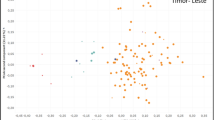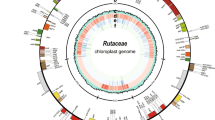Abstract
The inter-retrotransposon amplified polymorphism (IRAP) protocol was applied for the first time within the genus Helianthus to assess intraspecific variability based on retrotransposon sequences among 36 wild accessions and 26 cultivars of Helianthus annuus L., and interspecific variability among 39 species of Helianthus. Two groups of LTRs, one belonging to a Copia-like retroelement and the other to a putative retrotransposon of unknown nature (SURE) have been isolated, sequenced and primers were designed to obtain IRAP fingerprints. The number of polymorphic bands in H. annuus wild accessions is as high as in Helianthus species. If we assume that a polymorphic band can be related to a retrotransposon insertion, this result suggests that retrotransposon activity continued after Helianthus speciation. Calculation of similarity indices from binary matrices (Shannon’s and Jaccard’s indices) show that variability is reduced among domesticated H. annuus. On the contrary, similarity indices among Helianthus species were as large as those observed among wild H. annuus accessions, probably related to their scattered geographic distribution. Principal component analysis of IRAP fingerprints allows the distinction between perennial and annual Helianthus species especially when the SURE element is concerned.




Similar content being viewed by others
References
Ammiraju JS, Zuccolo A, Yu Y, Song X, Piegu B, Chevalier F, Walling JG, Ma J, Talag J, Brar DS, SanMiguel PJ, Jiang N, Jackson SA, Panaud O, Wing RA (2007) Evolutionary dynamics of an ancient retrotransposon family provides insights into evolution of genome size in the genus Oryza. Plant J 52:342–351
Boeke JD, Corces VG (1989) Transcription and reverse transcription of retrotransposons. Ann Rev Microbiol 43:403–434
Cavallini A, Zolfino C, Natali L, Cionini G, Cionini PG (1986) Nuclear DNA changes within Helianthus annuus L.: origin and control mechanism. Theor Appl Genet 73:20–26
Cheres MT, Knapp SJ (1998) Ancestral origins and genetic diversity of cultivated sunflower: analysis of the pedigrees of public germplasm. Crop Sci 38:1476–1482
Harter AV, Gardner KA, Falush D, Lentz DL, Bye RA, Rieseberg LH (2004) Origin of extant domesticated sunflowers in eastern North America. Nature 430:201–205
Hawkins JS, Hu G, Rapp RA, Grafenberg JL, Wendel JF (2008) Phylogenetic determination of the pace of transposable element proliferation in plants: Copia and LINE-like elements in Gossypium. Genome 51:11–18
Huff DR, Peakall R, Smouse PE (1993) RAPD variation within and among natural populations of outcrossing buffalograss [Buchloë dactyloides (Nutt.) Engelm.]. Theor Appl Genet 86:927–934
Jaccard P (1908) Nouvelles recherches sur la distribution florale. Bull Soc Vaud Sci Nat 44:223–270
Jing R, Johnson R, Seres A, Kiss G, Ambrose MJ, Knox MR, Ellis THN, Flavell AJ (2007) Gene-based sequence diversity analysis of field pea (Pisum). Genetics 177:2263–2275
Kalendar R, Schulman AH (2006) IRAP and REMAP for retrotransposon based genotyping and fingerprinting. Nature Protocols 1:2478–2484
Kalendar R, Grob T, Regina M, Suoniemi A, Schulman AH (1999) IRAP and REMAP: two new retrotransposon-based DNA fingerprinting techniques. Theor Appl Genet 98:704–711
Kalendar R, Tanskanen J, Immonen S, Nevo E, Schulman AH (2000) Genome evolution of wild barley (Hordeum spontaneum) by BARE-1 retrotransposon dynamics in response to sharp microclimatic divergence. Proc Natl Acad Sci USA 97:6603–6607
Kalendar R, Vicient CM, Peleg O, Anamthawat-Jonsson K, Bolshoy A, Schulman AH (2004) Large retrotransposon derivatives: abundant, conserved but nonautonomous retroelements of barley and related genomes. Genetics 166:1437–1450
Kalendar R, Tanskanen J, Chang W, Antonius K, Sela H, Peleg O, Schulman AH (2008) Cassandra retrotransposons carry independently transcribed 5S RNA. Proc Natl Acad Sci USA 105:5833–5838
Kobayashi S, Goto-Yamamoto N, Hirochika H (2004) Retrotransposon-induced mutations in grape skin colour. Science 304:982
Kumar A, Bennetzen J (1999) Plant retrotransposons. Annu Rev Genet 33:479–532
Lentz DL, Pohl MD, Alvarado JL, Tarighat S, Bye R (2008) Sunflower (Helianthus annuus L.) as a pre-Columbian domesticate in Mexico. Proc Natl Acad Sci USA 105:6232–6237
Ma J, Bennetzen JL (2004) Rapid recent growth and divergence of rice nuclear genomes. Proc Natl Acad Sci USA 101:12404–12410
Meudt HM, Clarke AC (2007) Almost forgotten or latest practice? AFLP applications, analyses and advances. Trends Plant Sci 12:106–117
Morse AM, Peterson DG, Islam-Faridi MN, Smith KE, Magbanua Z, Garcia SA, Kubisiak TL, Amerson HV, Carlson JE, Nelson CD, Davis JM (2009) Evolution of genome size and complexity in Pinus. PLoS ONE 4:e4332
Natali L, Giordani T, Cavallini A (2003) Sequence variability of a dehydrin gene within Helianthus annuus. Theor Appl Genet 106:811–818
Natali L, Santini S, Giordani T, Minelli S, Maestrini P, Cionini PG, Cavallini A (2006) Distribution of Ty3-gypsy- and Ty1-copia-like DNA sequences in the genus Helianthus and other Asteraceae. Genome 49:64–72
Nei M (1987) Molecular evolutionary genetics. Columbia University Press, New York, NY
Neumann P, Koblízková A, Navrátilová A, Macas J (2006) Significant expansion of Vicia pannonica genome size mediated by amplification of a single type of giant retroelement. Genetics 173:1047–1056
Orloci L (1978) Multivariate analysis in phytosociology: partition, classification and prediction. J Theor Biol 20:271–284
Peakall R, Smouse PE (2006) GENEALEX 6: genetic analysis in Excel, Population genetic software for teaching and research. Mol Ecol Notes 6:288–295
Rieseberg LH, Van Fossen C, Desrochers A (1995) Hybrid speciation accompanied by genomic reorganization in wild sunflowers. Nature 375:313–316
Rogers CE, Thompson TE, Seiler GJ (1982) Sunflower species of the United States. National Sunflower Association, Bismarck, North Dakota
Rohlf FJ (2000) NTSys-pc: numerical taxonomy and multivariate analysis system Version 2.1. Exeter Software, New York
Rozas J, Rozas R (1999) DnaSP version 3: an integrated program for molecular population genetics and molecular evolution analysis. Bioinformatics 15:174–175
Sabot F, Schulman AH (2006) Parasitism and the retrotransposon life cycle in plants: a hitchhiker’s guide to the genome. Heredity 97:381–388
SanMiguel P, Tikhonov A, Jin YK, Motchoulskaia N, Zakharov D, Melake-Berhan A, Springer PS, Edwards KJ, Lee M, Avramova Z (1996) Nested retrotransposons in the intergenic regions of the maize genome. Science 274:765–768
Santini S, Cavallini A, Natali L, Minelli S, Maggini F, Cionini PG (2002) Ty1/Copia- and Ty3/Gypsy-like DNA sequences in Helianthus species. Chromosoma 111:192–200
Schilling EE (1997) Phylogenetic analysis of Helianthus (Asteraceae) based on chloroplast DNA restriction site data. Theor Appl Genet 94:925–933
Schilling EE, Linder CR, Noyes RD, Rieseberg LH (1998) Phylogenetic relationships in Helianthus (Asteraceae) based on nuclear ribosomal DNA internal transcribed spacer region sequence data. Syst Bot 23:177–187
Schulman AH, Flavell AJ, Ellis THN (2004) The application of LTR retrotransposons as molecular markers in plants. Methods Mol Biol 260:145–173
Shannon CE, Weaver W (1949) The mathematical theory of communication. University of Illinois Press, Urbana, IL
Sossey-Alaoui K, Serieys H, Tersac M, Lambert P, Schilling EE, Griveau Y, Kaan F, Bervillé A (1998) Evidence for several genomes in Helianthus. Theor Appl Genet 97:422–430
Suoniemi A, Anamthawat-Jónsson K, Arna T, Schulman AH (1996) Retrotransposon BARE-1 is a major, dispersed component of the barley (Hordeum vulgare L.) genome. Plant Mol Biol 30:1321–1329
Suoniemi A, Schmidt D, Schulman AH (1997) BARE-1 insertion site preferences and evolutionary conservation of RNA and cDNA processing sites. Genetica 100:219–230
Tanskanen JA, Sabot F, Vicient C, Schulman AH (2007) Life without GAG: The BARE-2 retrotransposon as a parasite’s parasite. Gene 390:166–174
Thompson JD, Desmond G, Gibson H, Gibson TJ (1994) CLUSTAL W: improving the sensitivity of progressive multiple sequence alignment through sequence weighting, position-specific gap penalties and weight matrix choice. Nucl Acids Res 22:4673–4680
Ungerer MC, Strakosh SC, Zhen Y (2006) Genome expansion in three hybrid sunflower species is associated with retrotransposon proliferation. Curr Biol 16:R872–R873
Waugh R, McLean K, Flavell AJ, Pearce SR, Kumar A, Thomas WTB, Powell W (1997) Genetic distribution of BARE-1-like retrotransposable elements in the barley genome revealed by sequence-specific amplification polymorphisms (S-SAP). Mol Gen Genet 253:687–694
Whelan EDP (1978) Cytology and interspecific hybridization. In: Carter JF (ed) Sunflower Science and Technology, Am. Soc. Agronomy, Madison, Wis, pp 339–370
Wicker T, Sabot F, Hua-Van A, Bennetzen JL, Capy P, Chalhoub B, Flavell AJ, Leroy P, Morgante M, Panaud O, Paux E, SanMiguel P, Schulman AH (2007) A unified classification system for eukaryotic transposable elements. Nature Rev Genet 8:973–982
Witte CP, Le QH, Bureau T, Kumar A (2001) Terminal-repeat retrotransposons in miniature (TRIM) are involved in restructuring plant genomes. Proc Natl Acad Sci USA 98:13778–13783
Yeh FC, Yang RC, Boyle TBJ (1999) POPGENE version 1.32, Microsoft Window-based free ware for population genetic analysis. Computer program and documentation distributed by University of Alberta and Centre for International Forestry Research, Alberta, Canada. http://www.ualberta.ca/;fyeh/index.htm
Acknowledgments
Research work supported by PRIN-MIUR, Italy, Project “Variabilità di sequenza ed eterosi in piante coltivate”. M. V. was supported by a 6 months mobility scholarship issued by the Finnish Centre of International Mobility (CIMO).
Author information
Authors and Affiliations
Corresponding author
Additional information
Communicated by A. Bervillé.
Electronic supplementary material
Below is the link to the electronic supplementary material.
Rights and permissions
About this article
Cite this article
Vukich, M., Schulman, A.H., Giordani, T. et al. Genetic variability in sunflower (Helianthus annuus L.) and in the Helianthus genus as assessed by retrotransposon-based molecular markers. Theor Appl Genet 119, 1027–1038 (2009). https://doi.org/10.1007/s00122-009-1106-2
Received:
Accepted:
Published:
Issue Date:
DOI: https://doi.org/10.1007/s00122-009-1106-2




